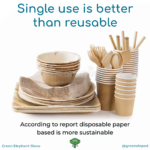What is an "Organisational Vision"?
Defining and communicating an Organisational, or Company Vision is not just restating what you do as an organisation. That is referred to as a ‘mission’ and is more centred on the here and now. Every organisation should be able to describe what they see as their future. A statement of this Vision should reveal what an organisation most hopes to be and what they want to achieve in the long term.
It's good to document your Vision
It may be that you’ve got your vision in your head. Perhaps you’ve shared it with people that are close to you. Why would you want to write it down?
As with so many goals, the more people you tell the more encouragement you will get. You may, of course, also get feedback. It has to be said, that feedback could be positive and negative. However, you can use any and all feedback to affirm and refine your Vision.
If your employees understand, and buy into, where the organisation is heading, they will naturally start trying to achieve it. If your customers like where you’re going they will stay with you or share your Vision with others. As for investors and potential partners, they are always looking for ambitious and achievable Visions to which they can contribute.
How to write a Company Vision
A Vision is not always on the tip of your tongue. Many organisational leaders are so focused in delivering the day-to-day ‘mission’ that they rarely spend the time to think of the distant future. So, how do you come up with a Company Vision? Let’s consider 7 tips on creating a compelling organisational Vision.
1. Review where your influencers and competitors are going
Having a look at what your competition is up to should be a regular event. However, researching where they are going in the coming years might help fuel your own future gazing. Equally important is looking at the other organisations and people that influence you.
Your influencers include employees, customers, partners, industry leaders and the government:
- Some of the most innovative ideas for your organisation are already in the heads of the people you employ. However, you do have to listen and provide a way for these to surface. You could consider a reward scheme for the selected ideas.
- Understanding what your customers are starting to look for, especially if they are struggling to find it, is a good source of information. Find a way to gather these insights and learn from them.
- What are your organisation’s partners going to be looking for from your relationship in the future? This could also be a great reason to sit down and discuss how you could be more effective together.
- Industry leaders, which could include governing bodies, tend to clearly state where they think your industry is going. Emerging techniques and technologies are good to consider as a source of ideas.
- The government regularly sets, and updates, policies and targets which could affect you or identify something you could commit to supporting in the coming years.
2. Imagine what the organisation does in 5 to 10 years
This is easier said than done. It does mean taking some time out and giving people a chance to think. When ideas surface, do not beat them down with “oh that won’t work” or “we tried that once” or other such creativeness killers. Try “Yes, and…“. When someone comes up with an idea, respond with “Yes, and”, then add to the suggestion instead of taking away from it.
You could also use Six Thinking Hats as a technique to provide a better environment for creativeness.
3. Dream big and focus on what success looks like
It’s very good to be rooted in reality, but sometimes you need to step outside your comfort zone and dream of how great you could be. What would that look like? How would it positively change the experience for your employees, customers, partners or the world? Don’t think about how you’d do it or the barriers you’d have to overcome. Just say “what if we did …”.
4. Describe it like it's already a reality
5. Be inspiring and passionate but clear, concise and avoiding jargon
Going back to the founding Microsoft Vision “A computer on every desk and in every home”. It’s simple, short and leaves the reader to make their own opinion on it’s impact. The jargon, at the time, was the word “computer”. However, there was no technical details, no buzz words, nothing that couldn’t be quickly understood. Probably worth remembering that Microsoft was NOT a hardware company at that point. However, they knew that a computer on every desk meant software on every desk too.
6. Make sure it fits with your Values and Mission
Your vision must fit in with your organisation’s reason for existing and the Values it upholds. What use is a Vision if it betrays your reason for being. You could be an organic farmer and have a vision of developing pesticides, creating a huge conflict. Having said that, this doesn’t mean you can’t branch out, break into new markets or propose radical new ideas. However, you need to make sure they do not conflict with the organisations ethics or purpose.
7. Put a plan together to make the Vision a reality
So you’ve gathered insights, crafted a new future, word-smithed a beautiful statement and those that have seen the Vision have swooned in delight! It’s all meaningless unless you follow through with a plan and a commitment to achieving what you’ve said. To start with, this can be fairly overview and scant on detail, but you need to show the steps you’re going to take to make this a reality. Otherwise, it’s just words and your brand will be damaged if you are perceived as “all bark and no bite”.
Making the best use of your Company Vision
If you are driver you know that you have to ensure your car is fit to be on the road and appropriate for for trips you make. You may also have to consider changes in driving conditions. Then, if you’re going somewhere different you may well check a map or use satellite navigation. Finally, for this illustration, you make sure you have everything you need to arrive safely.
Similarly, if you are running an organisation, you are constantly tuning and changing how you do things – Are those changes impacting or delivering your Vision?
The world changes too; new technology, new governments, new rules all affect the conditions you are operating in, So, do these new conditions affect your Vision, does it need to be adjusted?
The Vision you’ve set is your organisations destination. It’s likely to need many small journeys to get you there and there will be diversions. Are you still heading towards your Vision or have you been sidetracked and heading in the wrong direction. Alternatively, has your Vision changed?
Finally, keep refining the plan and make sure you are giving it enough attention and resources.
Simply put, keep a close eye on your Organisation’s Vision.




